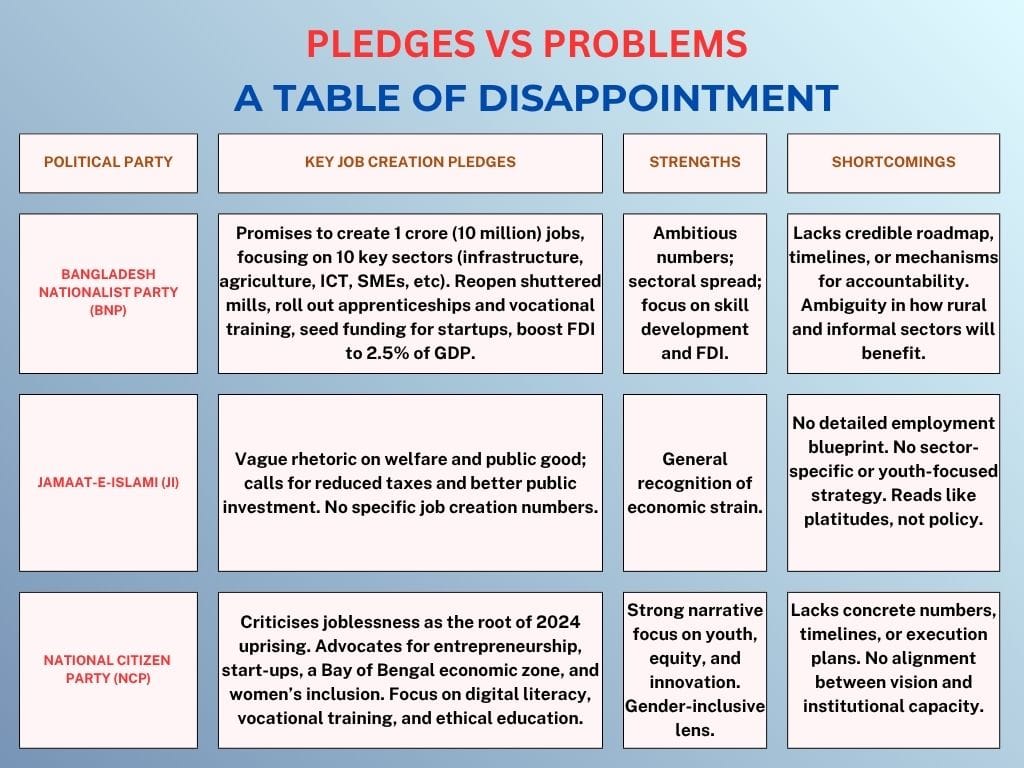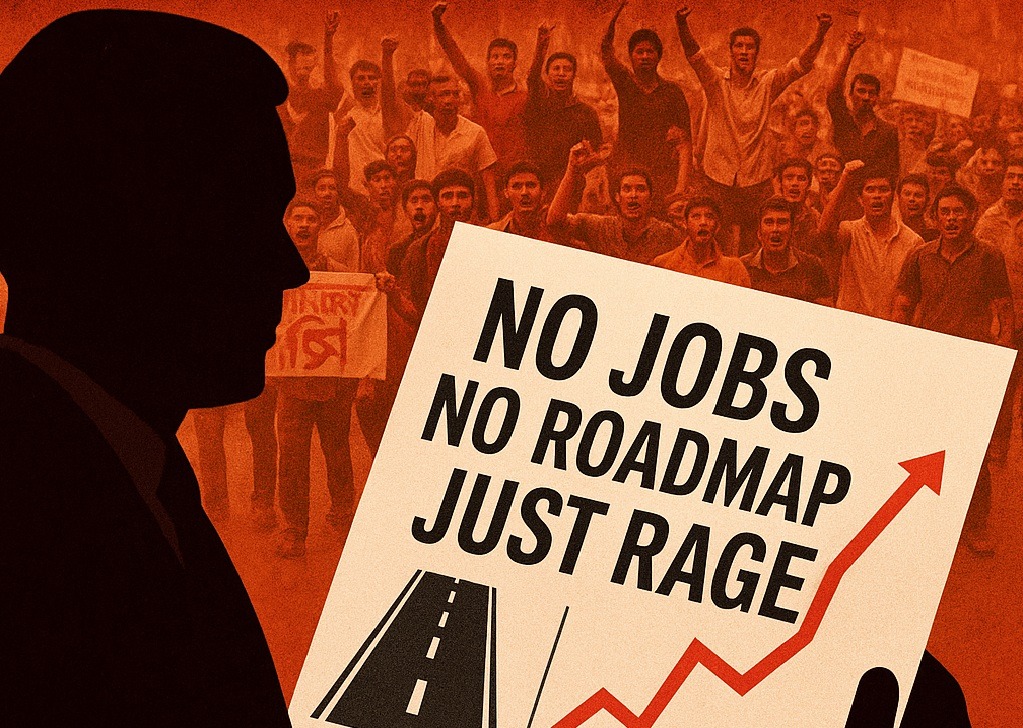Bangladesh’s biggest asset—its youth—is being wasted. Parties are promising jobs, but their blueprints are more like napkin drawings. The next rebellion won’t be quiet.
The recently published UNFPA State of World Population 2025 report lays bare a truth long echoed across the Global South: without economic stability and human development, aspirations become ticking time bombs. Nowhere is this more palpable than in Bangladesh, where a growing mass of underemployed youth watches political pledges cascade like confetti—colourful, plentiful, and ultimately, useless if not backed by real substance.
As the country eyes a general election in early 2026, a cold fact looms large: the promises made by Bangladesh’s major political parties are alarmingly insufficient to tackle the scale of its youth employment crisis. The consequences? A repeat—or even escalation—of the unprecedented July–August 2024 mass uprising, when tens of thousands, mostly young, took to the streets demanding nothing more radical than jobs and justice.
The demographic pressure cooker
With a 2025 population of 175.7 million, Bangladesh is brimming with potential—and peril. A staggering 115 million citizens fall within the working-age bracket (15–64), and nearly 50 million are aged 10–24. This youth bulge could be the engine of a golden era, or the spark for uncontainable social turmoil.
Youth unemployment stood at 11.46% in 2024, but this figure barely scratches the surface. Millions more are underemployed, informally employed, or stuck in a limbo between graduation and opportunity. If this vast cohort continues to find doors closed, it will no longer knock—it will break them down, as we saw during the weeks of unrest last year.
Pledges vs problems: a table of disappointment

Echoes of July 2024: a nation on the edge
The July–August 2024 uprising was more than a policy protest—it was a social rupture. Sparked by frustration over public sector recruitment and perceived cronyism, people’s unrest swelled into a youth-driven rebellion against a broken promise of opportunity. Supreme Court rulings affirming meritocracy only added fuel to the fire; it was never just about quotas—it was about despair.
To get some insight into what path the future of Bangladesh might take, think back to the Arab Spring. The revolution erupted across the Middle East due to a volatile mix of youth unemployment; elite disconnect and rising inequality. Tunisia’s Mohamed Bouazizi set himself ablaze not for politics, but for economic dignity. In Sri Lanka, the 2022 mass protests over inflation and job scarcity unseated a sitting president. Bangladesh, too, has entered this danger zone.
The illusion of numbers: why these pledges are not enough
Even BNP’s “1 crore jobs” promise, while headline-worthy, collapses under scrutiny. What kind of jobs? For whom? Where? How fast? Are these formal, sustainable roles or underpaid gig work?
JI’s abstract overtures do little more than signal economic virtue. And while NCP’s ideas resonate with young voters, their manifesto is more poetry than policy—no financial plans, no institutional buy-in, and no operational clarity.
What all parties lack is a unified, data-driven, and transparent action plan to bridge the chasm between demographic pressure and economic opportunity.
The road to redemption: seven pillars for true reform
To avert another eruption—and build lasting stability—Bangladesh must move beyond promises to implement transformative reforms aligned with UNFPA’s human development framework-
Human capital revolution: Invest massively in quality education, digital skills, and demand-driven vocational training. Align academic curricula with market realities. Incentivise critical thinking, not rote learning.
Entrepreneurship ecosystem: Develop infrastructure for start-ups through tax holidays, incubators, mentorships, and one-stop registration portals. SMEs should be the fulcrum of job creation.
Credible investment environment: Build legal certainty, crackdown on corruption, and guarantee policy continuity. Prioritise sectors like green tech, logistics, and agritech for FDI.
Youth-centric job strategies: Launch a National Youth Employment Mission with quotas for first-time job seekers, internship guarantees, and universal career counselling in secondary education.

Women in work: Address barriers such as workplace safety, transport, childcare, and property rights. Implement gender-sensitive budgeting and mandate representation in economic decision-making.
Agricultural modernization: Revive the rural economy by promoting high-value crops, modern irrigation, and farm-to-market logistics. Transform farming into a high-tech, youth-friendly sector.
Real-time labour data: Create a digital labour market observatory to track job trends, predict skills gaps, and measure policy impacts. No data, no development.
The final reckoning: a generation is watching
Bangladesh’s political leaders are now at a historic juncture. Their promises are being recorded, not just by journalists and researchers, but by millions of unemployed graduates, disenfranchised rural youths, and disillusioned urban workers. The cost of inaction is no longer political — it is existential.
The coming election is a referendum not just on leadership but on whether Bangladesh’s political elite understand the stakes. Will they channel the energy of their youthful population into prosperity—or provoke it into another explosive outburst?
If parties continue to trade in vague slogans and electioneering gimmicks, the country risks sliding into a spiral of economic disillusionment and political instability. But if they summon the courage to act boldly and decisively, they might just harness the might of their youth before it becomes their fiercest opposition.
The fire that raged in the streets during the 2024 mass uprising has not been extinguished. It simmers—quiet, angry, and waiting. If the parties fail to move beyond rhetoric to action, they may find themselves not in the corridors of power, but once again confronted by the fury of a generation that refuses to be ignored.
Adil Mahmood is a former journalist.


